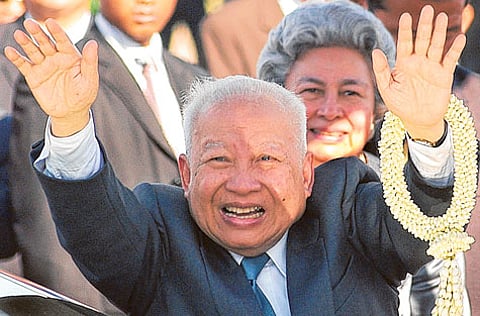Cambodia former king Norodom Sihanouk dies
Played key role in turbulent history

Phnom Penh: Former king Norodom Sihanouk, who dominated Cambodia’s political scene for nearly six decades and was regarded as the father of modern Cambodia, died on Monday at the age of 89.
Sihanouk was inextricably linked to his country’s turbulent and tragic recent history. He played numerous roles in Cambodian affairs as king, peacemaker, resistance leader and prisoner of the genocidal Khmer Rouge regime.
The constitutional monarch had limited political power, but he was revered by many Cambodians. Throughout his life, he worked to improve the lives of his people, with whom he claimed to have a special relationship that transcended politics.
He was quoted by The New York Times as saying he followed one course in politics: “the defence of the independence, the territorial integrity and the dignity of my country and my people.”
Born in Phnom Penh in 1922, Sihanouk ascended to the throne in 1941 at 19. The French colonial administration that installed Sihanouk did so thinking he would be pliant and naive, but its strategy failed as he led a movement to gain independence from France, which was granted to Cambodia in 1953.
Sihanouk, unwilling to be constrained by constitutional statutes that prevented the monarch from playing a political role, abdicated in 1955 in favor of his father, Suramarit, and threw himself into the political arena.
The semi-divine status accorded to the Cambodian monarchy ensured Sihanouk an easy victory in 1955 elections, and for the next 15 years, he dominated politics.
Sihanouk spearheaded the Sangkum Reastr Niyum, or People’s Socialist Community, a political organization that controlled the government through 1970, a time that would be later viewed as modern Cambodia’s golden era.
Throughout the Sangkum period, the then-prince held and executed absolute power. While he commonly ordered crackdowns on opposition press and political dissenters, Sihanouk also undertook massive public works projects and made advances in education.
Yugoslavia leader Josip Broz Tito, who along with Sihanouk was a founder of the Non-Aligned Movement, said after a trip to Cambodia during the Sangkum period: “I found that Cambodia was a flourishing country with a high standard of living and an advanced industrial potential. This is a country ... which really wants to [keep] itself from being involved in disaster. Unfortunately, this does not depend on them.”
Tito’s appraisal proved to be prescient. Despite Sihanouk’s attempts to assert Cambodia’s neutrality, the country was soon engulfed in the US war in neighbouring Vietnam.
Sihanouk was overthrown by his defence minister, Lon Nol, in a US-backed coup in early 1970 while abroad and soon after began the first of many stints as the head of a resistance movement in exile.
Among the groups in the anti-Lon Nol resistance were communist insurgents that Sihanouk dubbed “les Khmer Rouge,” or red Cambodians, a name that would forever haunt Cambodia.
Sihanouk eventually returned to Phnom Penh in late 1975 after the Khmer Rouge toppled the Lon Nol regime.
No longer of political value to the Khmer Rouge, Sihanouk was placed under house arrest at the Royal Palace while the movement embarked on one of the most radical, bloody social experiments in history.
“I understand very well that when I am no longer useful to them, they’ll spit me out like a cherry pit,” Sihanouk said of the Khmer Rouge in a 1973 interview.
An estimated 1.7 million to 2.2 million Cambodians, including five of Sihanouk’s 14 grandchildren, died from forced labour, starvation, disease and summary executions from 1975 to 1979 in the Khmer Rouge’s failed attempt to create an agrarian utopia.
After the Khmer Rouge’s ouster in a 1979 Vietnamese invasion and occupation, Sihanouk became the head of yet another resistance movement, which sought Vietnam’s withdrawal from the country.
Moving between his residences in North Korea and Beijing, Sihanouk was eventually able to bring together Cambodian leaders of the resistance and the Vietnamese-installed regime for peace talks, which resulted in Vietnam’s withdrawal in 1989.
Sihanouk was a central figure in brokering the historic 1991 Paris Peace Accords, which led to a massive UN peacekeeping effort and UN-run elections in 1993. The elections resulted in an uneasy coalition government led by Hun Sen, a leader of the Vietnamese-installed regime, and Prince Norodom Ranariddh, the king’s son.
Sihanouk once again ascended to the throne after the 1993 polls as constitutional monarch and sought until his death to ensure Cambodia’s political stability without being seen as actively participating in politics.
By the late 1990s, the king’s heath had deteriorated, and he spent much of his time in Beijing undergoing medical treatment for a variety of ailments, including cataracts and arteriosclerosis.
He abdicated in 2004 because of poor health, allowing his son Norodom Sihamoni to take the throne.
He died in Beijing.
Sign up for the Daily Briefing
Get the latest news and updates straight to your inbox



